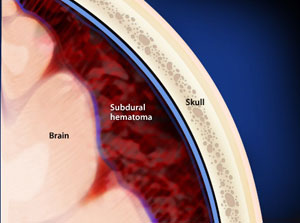Craniotomy for Subdural Haematoma
Information about Surgery for Subdural and Intracranial Haemorrhage
|
A subdural haematoma (SDH) is a blood clot that occurs in the subdural space, between the skull and the brain. Subdural haematomas commonly result from trauma to the head.
Some subdural haematomas can be large and acute requiring emergency surgery. Other subdural haematomas can be chronic and be managed without surgery. Sometimes subdural haematomas can place harmful pressure on the brain. When symptoms develop they include headache, drowsiness and weakness. Dr Oehme will advise you on on whether surgery is required to drain the blood clot. Craniotomy to drain a subdural haematoma is performed under general anaesthesia, and creates an opening through the skull for removal of the blood clot on the surface of the brain and to stop any bleeding. For more information about surgery for subdural haematoma watch the video below. |
 |
Risks of Craniotomy for Subdural Haematoma
Dr Oehme will advise if surgery is required to drain a subdural haematoma. Like any surgical procedure there are risks associated with the anaesthetic and the procedure itself.
Risks of Anaesthesia
Risks of anaesthesia will be discussed with you by your anaesthetist prior to surgery. It is important that you inform us of your correct age and any past medical problems, as this can influence the risk of anaesthesia. Risks include:
- Heart problems, such as heart attack (AMI) or arrhythmia
- Lung problems, such as infection (pneumonia) or blood clots
- Urinary tract infection
- Deep Venous Thrombosis (DVT)
- Eye or visual problems
- Pressure wounds
- Stroke
- Small risk of significant life-threatening event
General Risks of Craniotomy
Although surgery for subdural haematomas is generally safe, there are some risks whenever performing a craniotomy. These include:
- Infection 1-2%
- Seizures which can require taking medication. Rarely this can lead to epilepsy requiring longterm medication.
- Bleeding. This can occur at the time of surgery and may necessitate a blood transfusion. It can also occur at some time after surgery. The bleeding may be present in the brain or adjacent to it. Sometimes another operation is required to drain the bloodclot and stop the bleeding.
- Stroke
- Brain fluid leak (CSF leak)
- Small risk of significant neurological injury causing paralysis, coma or death.
Specific Risks of Craniotomy for Craniotomy for Subdural Haematoma
The specific risks of draining a subdural haematoma will be discussed in detail prior to your surgery but may include:
- Weakness or numbness in the limbs
- Visual disturbance
- Speech disturbance or paralysis (stroke like symptoms).
- Cognitive impairment and memory problems
- Incomplete removal
- Recurrence of the haematoma
- Requirement for further treatment with re-drainage
